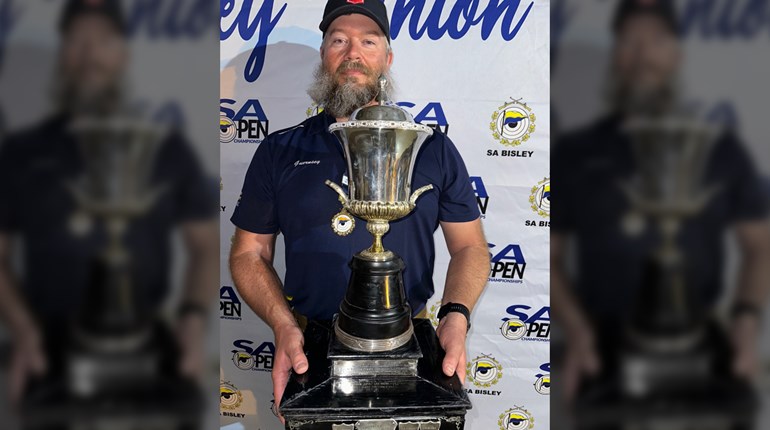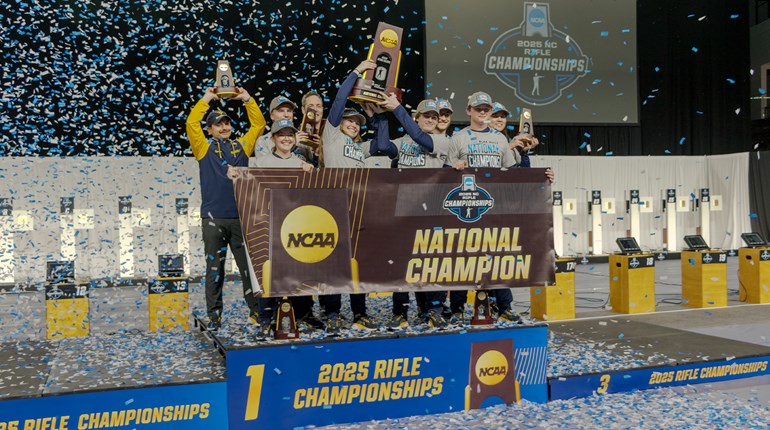
Above: TRX straps are beneficial for increasing strength and endurance, allowing for hundreds of different movements.
Shooters who are active and in good condition can improve their shooting scores faster and often are able to perform better in competition. There are several benefits to a physical fitness program for shooters.
A good physical fitness program for shooters should include sport or physical training activities from each of the following areas: aerobics, flexibility improvement, strength training, and participation in other team or individual sports. Also, it’s a good idea to check with your doctor before embarking on an ambitious physical fitness program—especially if you haven’t exercised in a while.

Aerobic sports are exercises such as cycling, running or swimming, which condition the heart, lungs and circulatory system by helping your body take in more oxygen and use it better. Aerobic exercise should be done five to six days per week and should last at least 20 minutes a day. The best aerobic sports for shooters are running and swimming. A daily 15 to 20 minute jog or swim is an excellent addition to any shooter’s training program. Cross-country skiing is also great exercise.

Flexibility exercises such as stretching should be part of a shooter’s training program. Here are some exercises that are good for shooters.
Strength exercises are also very important. Enhanced muscle strength aids in taking the weight of the firearm, holds the body still and controls movement of the gun. Rifle shooting positions require that some muscles be relaxed while others are tense. The ability to control muscle tension and to relax certain muscles is improved by overall strength.
Strength exercises are very specific. It’s important that you strengthen the muscles you will be using. Activities that increase leg and upper body strength are especially good. Sit-ups build stomach muscles used in standing. Additionally, holding the rifle in position is a good isometric exercise.
There are many other sports which are helpful to shooting. Some of the best sports for shooting are cross-country skiing, cycling, skating and table tennis. Ping pong? One of the best. Not only does it strengthen arm, leg and core muscles, but its easy on the joints and increases mental acuity. Team sports such as soccer and volleyball are also good.
Other important parts of fitness include eating a well-balanced diet, making sure you are getting enough rest, and staying hydrated.

The benefits of physical fitness for competitive shooters can’t be understated. For a better look at keeping fit beyond the basic exercises outlined above, SSUSA talked to Elizabeth Harty of the 2017 Goodwill Randle Team. She is a fitness enthusiast who is well-versed with how workouts geared towards improving scores at matches can produce results.
“It is definitely beneficial to do body weight exercises, like push-ups, crunches, and planks,” said Harty. “When I was captain of the Michigan Rifle Team we had workouts every day. When many of our shooters were on the [leader] board, they saw how the workouts reflected in their scores! Think about it, in a match how long do you have to hold up your rifle? How long are you standing in your shooting stance? Without being in good overall health it could make those aspects harder in a competition.”
When she first started shooting, Harty had recently finished her swimming career of 15 years. She noted that the fitness that swimming brought her gave her a boost when she began shooting competitively.
“If I didn’t have the swimmer body like I did, I do not think I would have started off as well in my shooting career,” said Harty.
Mens sana in corpore sano is a Latin phrase dating to the 1st century AD. It means “A healthy mind in a healthy body.” Keeping yourself in good shape will benefit your mind, and the extra strength you gain will definitely improve position shooting. Harty noted the benefits of increased muscle power.
“It’s very important to make sure your overall health and fitness is a priority, because it will be reflected in your shooting scores,” said Harty. “Having strong arms allows you to hold the rifle, having a strong core gives you a strong base in stabilizing your stance, and strong legs will enhance your stance and balance.”

Harty has found a new class that combines strength and endurance she enjoys.
“I currently do Orangetheory Fitness. OTF is amazing because all you have to do is show up to class,” said Harty. “The coach takes you through the class, which combines power, strength and endurance in a 60 minute session. Combining the three gives you a total body workout. The great thing about OTF is that you can achieve an ‘afterburn’ effect, where you burn calories 24-36 hours after the workout. Therefore you don’t have to work out every single day, which definitely helps out my shooting training!”
Getting started in rifle competition? Read the first installment of our Rifle Fundamentals series.
Shooters who are active and in good condition can improve their shooting scores faster and often are able to perform better in competition. There are several benefits to a physical fitness program for shooters.
- Being in good shape increases your ability to handles stress in competition.
- Greater flexibility and improved circulation help you to develop coordination and control in shooting positions.
- Overall fitness contributes to general health and well-being.
A good physical fitness program for shooters should include sport or physical training activities from each of the following areas: aerobics, flexibility improvement, strength training, and participation in other team or individual sports. Also, it’s a good idea to check with your doctor before embarking on an ambitious physical fitness program—especially if you haven’t exercised in a while.

Don't forget the cardio! At OTF, the cardio is between the treadmills and the water rower. The treadmill has a flex deck in it to absorb impacts. Water rowing is a great exercise that uses 85 percent of your body.
Aerobic sports are exercises such as cycling, running or swimming, which condition the heart, lungs and circulatory system by helping your body take in more oxygen and use it better. Aerobic exercise should be done five to six days per week and should last at least 20 minutes a day. The best aerobic sports for shooters are running and swimming. A daily 15 to 20 minute jog or swim is an excellent addition to any shooter’s training program. Cross-country skiing is also great exercise.

Making time for exercise is one of the best training investments you can make.
Flexibility exercises such as stretching should be part of a shooter’s training program. Here are some exercises that are good for shooters.
- Neck roll—Tip the head down and slowly rotate it first to the right and then to the left. Do five times in each direction.
- Trunk stretch—Extend hands overhead and bend to side. Stay in stretching position 15 to 20 seconds. Do two stretches to left and two to right.
- Trunk twister—Stand with feet shoulder-width apart and arms extended to sides. With right hand, bend and reach to touch left toe. Return to starting position, then bend and reach for right toe. Repeat 10 times.
- Thigh stretcher—Raise knee as high as possible and hold it against body for 15 to 20 seconds. Do twice with each leg.
- Achilles stretch—Stand about two feet from a wall or pole and support body with hands. Lean forward, keeping body and legs straight to stretch Achilles tendons at back of ankles. Do two stretches of 15 to 20 seconds each.
- Lunge—Step forward with left leg, bending knee as far as it will go. Hold for 15 to 20 seconds. Repeat with right leg. Do two stretches with each leg.
- Groin stretch—Sit with bottoms of feet touching and knees bent. Grab feet with hands and pull head down to feet. Hold stretch for 10 to 15 seconds. Do four times.
Strength exercises are also very important. Enhanced muscle strength aids in taking the weight of the firearm, holds the body still and controls movement of the gun. Rifle shooting positions require that some muscles be relaxed while others are tense. The ability to control muscle tension and to relax certain muscles is improved by overall strength.
Strength exercises are very specific. It’s important that you strengthen the muscles you will be using. Activities that increase leg and upper body strength are especially good. Sit-ups build stomach muscles used in standing. Additionally, holding the rifle in position is a good isometric exercise.
There are many other sports which are helpful to shooting. Some of the best sports for shooting are cross-country skiing, cycling, skating and table tennis. Ping pong? One of the best. Not only does it strengthen arm, leg and core muscles, but its easy on the joints and increases mental acuity. Team sports such as soccer and volleyball are also good.
Other important parts of fitness include eating a well-balanced diet, making sure you are getting enough rest, and staying hydrated.

Smallbore competitor Elizabeth Harty believes there are major benefits for shooters that are active and physically fit.
The benefits of physical fitness for competitive shooters can’t be understated. For a better look at keeping fit beyond the basic exercises outlined above, SSUSA talked to Elizabeth Harty of the 2017 Goodwill Randle Team. She is a fitness enthusiast who is well-versed with how workouts geared towards improving scores at matches can produce results.
“It is definitely beneficial to do body weight exercises, like push-ups, crunches, and planks,” said Harty. “When I was captain of the Michigan Rifle Team we had workouts every day. When many of our shooters were on the [leader] board, they saw how the workouts reflected in their scores! Think about it, in a match how long do you have to hold up your rifle? How long are you standing in your shooting stance? Without being in good overall health it could make those aspects harder in a competition.”
When she first started shooting, Harty had recently finished her swimming career of 15 years. She noted that the fitness that swimming brought her gave her a boost when she began shooting competitively.
“If I didn’t have the swimmer body like I did, I do not think I would have started off as well in my shooting career,” said Harty.
Mens sana in corpore sano is a Latin phrase dating to the 1st century AD. It means “A healthy mind in a healthy body.” Keeping yourself in good shape will benefit your mind, and the extra strength you gain will definitely improve position shooting. Harty noted the benefits of increased muscle power.
“It’s very important to make sure your overall health and fitness is a priority, because it will be reflected in your shooting scores,” said Harty. “Having strong arms allows you to hold the rifle, having a strong core gives you a strong base in stabilizing your stance, and strong legs will enhance your stance and balance.”

Harty, along with her sister Caitlin (left), and Dublin OTF Coach Lizzy after a workout session.
Harty has found a new class that combines strength and endurance she enjoys.
“I currently do Orangetheory Fitness. OTF is amazing because all you have to do is show up to class,” said Harty. “The coach takes you through the class, which combines power, strength and endurance in a 60 minute session. Combining the three gives you a total body workout. The great thing about OTF is that you can achieve an ‘afterburn’ effect, where you burn calories 24-36 hours after the workout. Therefore you don’t have to work out every single day, which definitely helps out my shooting training!”
Getting started in rifle competition? Read the first installment of our Rifle Fundamentals series.


































